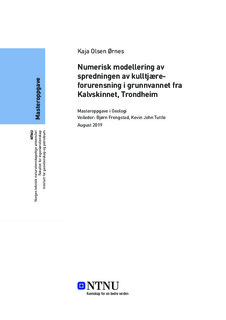| dc.contributor.advisor | Frengstad, Bjørn | |
| dc.contributor.advisor | Tuttle, Kevin John | |
| dc.contributor.author | Ørnes, Kaja Olsen | |
| dc.date.accessioned | 2019-10-25T14:00:30Z | |
| dc.date.available | 2019-10-25T14:00:30Z | |
| dc.date.issued | 2019 | |
| dc.identifier.uri | http://hdl.handle.net/11250/2624522 | |
| dc.description.abstract | Tidligere gassverksdrift har i hele den industrialiserte delen av verden ført til stor forurensningsproblematikk. Biprodukter fra produksjonen av gass fra steinkull ble ofte sluppet ut til miljøet ved disse anleggene. Et av biproduktene som skaper bekymring er kulltjære, en viskøs ikke-blandbar væske, også kalt non-aqueous phase liquid eller NAPL, med mange tusen ulike komponenter. Komponenter fra kulltjæren kan løses ut i og forurense grunnvannet, og transporteres videre bort fra kildeområdet.
Området som er studert i denne masteroppgaven ligger på Kalvskinnet i Midtbyen i Trondheim. På det aktuelle området ligger NTNU Kalvskinnet med tilhørende nybygg, Akrinn. Hele Midtbyen er en deltaavsetning avsatt ved utløpet til Nidelva under et stadig synkende havnivå. Grunnet tidligere gassverksvirksomhet på området, har løsmassene ved tomten vært betydelig forurenset. I forbindelse med bygging av Akrinn, NTNU, i 2014, ble store mengder forurenset masse fjernet. Etter gravearbeidet var grunnvannet ved området svært forurenset av blant annet PAH-forbindelser, BTEX og oljeforbindelser. Gravearbeidet mobiliserte høye konsentrasjoner av mobile tjærekomponenter.
I denne masteroppgaven er spredningen av høyeste målte konsentrasjon av oppløst naftalen og benzen i grunnvannet fra den tidligere gassverkstomten studert. Dette er gjort ved numerisk modellering i Visual MODFLOW Flex. Grunnvannsstrømningskoden MODFLOW-2000 og transportmotoren MT3DMS er brukt. Først ble en konseptuell modell for hele Midtbyen bygd opp. Denne ble oversatt til numerisk modell.
Transportmodellen er basert på kalibrert grunnvannsstrømningsmodell. Transportmodellen viser at oppløste komponenter i grunnvannet spres mot sørvest til Nidelva med grunnvannsstrømningen. Transport av oppløste komponenter mot sørvest er av bekymring med tanke på påvirkning av Nidelva. Plumen, eller ''skyen'', av oppløst naftalen og benzen når Nidelva, men dette tar lang tid. På ferden mot Nidelva vil naftalen og benzen tynnes ut og brytes ned av mikrobiell aktivitet. Dette resulterer i at kun minimale konsentrasjoner når Nidelva. Oppløst konsentrasjon fra gjenliggende forurensning har gradvis blitt redusert i tiden etter gravearbeidet, og vil dermed i enda mindre grad påvirke miljøet enn konsentrasjonen som er modellert.
Før modelleringen var antatt spredningsretning mot nordvest. Dette var basert på konsentrasjonsmålinger gjort i observasjonsbrønner ved området. Det har vært vanskelig å konkludere hvilken strømningsretning som virker mest sannsynlig. En modell tar høyde for alle kjente forhold ved området og visualiserer et helhetlig bilde av grunnvannssystemet, men usikkerheter i modellen kan føre til avvik fra virkeligheten. Det er argumenter for og imot antatt og modellert spredningsretning. Modellen bidrar uansett med verdifull informasjon. Den viser at plumen ikke vil transporteres langt før konsentrasjonen er betydelig redusert. | |
| dc.description.abstract | Former manufactured gas plants have caused pollution issues throughout the industrialised parts of the world. By-products from the production of gas from coal were regularly deposited or spilled out into the environment surrounding these plants. One of the by-products causing concern is coal tar, a non-aqueous phase liquid also known as NAPL, containing thousands of different compounds. Compounds from coal tar can be dissolved in and pollute the groundwater, which subsequently can be transported further away from the source.
The area studied in this thesis is situated on Kalvskinnet in Midtbyen in Trondheim, Norway. It is the location of NTNU Kalvskinnet and Akrinn. Midtbyen is a deltaic deposit. It was deposited at the mouth of the river Nidelva following declining sea levels after the last ice age. Due to former gas manufacturing at the site, the soil has been significantly contaminated. During construction of Akrinn, NTNU in 2014, a large amount of contaminated mass was removed. After the excavation, the groundwater at the site was highly contaminated by polycyclic aromatic hydrocarbons (PAH), BTEX and aliphatic hydrocarbons. The excavation mobilised great concentrations of mobile tar components.
In this thesis, the transport of the highest measured concentration of dissolved naphthalene and benzene in groundwater at the former manufactured gas site is studied. This is done by numerical modelling in Visual MODFLOW Flex 5.0. The flow engine MODFLOW-2000 and the transport engine MT3DMS is used for this purpose. A conceptual model of Midtbyen was developed and translated into a numerical model.
The transport model is based on a calibrated flow model. It shows that dissolved components in the groundwater is spreading southwest to Nidelva. Transport of dissolved contaminants southwest is of great concern as it can affect the recipient Nidelva. The plume of dissolved naphthalene and benzene reaches Nidelva, but it takes a long time. The plume will be diluted and degraded by microbial activity. This results in minimal concentrations in Nidelva. Dissolved concentrations from remaining coal tar pollution at the site have declined in the time since the excavation. It will therefore affect the environment to a lesser degree than the modelled concentration.
Prior to conducting this modelling work, the assumed direction of spreading was towards the northwest. This was based on measurements of concentration in wells at the site. It had been difficult to conclude the most likely direction of spreading. A model takes into account all known conditions at the site and visualises a comprehensive representation of the groundwater system, but uncertainties in the model may lead to deviations from reality. There are both arguments for and against the assumed and the modelled direction of spreading. The model still provides valuable information. It shows that the plume will not be transported far away from the site before the concentration is considerably reduced. | |
| dc.language | nob | |
| dc.publisher | NTNU | |
| dc.title | Numerisk modellering av spredningen av kulltjære-forurensning i grunnvannet fra Kalvskinnet, Trondheim | |
| dc.type | Master thesis | |
